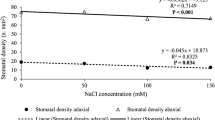Abstract
Pringlea antiscorbutica R. Br., a subantarctic endemic cruciferous species, is endangered in its natural sites by several ecological changes. This species is tolerant to salinity and a permanent cold temperature on Kerguelen and Crozet Islands. We attempted the investigation of regulating mechanisms of osmotic adjustment in this species. 13C NMR analyses of water-soluble compounds from leaves collected from the field revealed glucose and proline to be the main accumulated organic solutes. Colorimetric determinations in these samples showed that proline and soluble carbohydrates were present at remarkably high levels. When young plants were cultivated in growth chambers they showed a good resistance to cold and medium resistance to saline conditions. High levels of soluble carbohydrates were present in all situations. Proline was accumulated in response to a saline and a cold treatment. The quantitative variations of the pool of proline in response to saline treatments were rapid and important. The adaptive value of these responses of organic solutes in the tolerance of Pringlea antiscorbutica to various stresses is discussed.
Similar content being viewed by others
Author information
Authors and Affiliations
Additional information
Received: 16 June 1997 / Accepted: 5 May 1998
Rights and permissions
About this article
Cite this article
Hennion, F., Bouchereau, A. Accumulation of organic and inorganic solutes in the subantarctic cruciferous species Pringlea antiscorbutica in response to saline and cold stresses. Polar Biol 20, 281–291 (1998). https://doi.org/10.1007/s003000050304
Issue Date:
DOI: https://doi.org/10.1007/s003000050304




